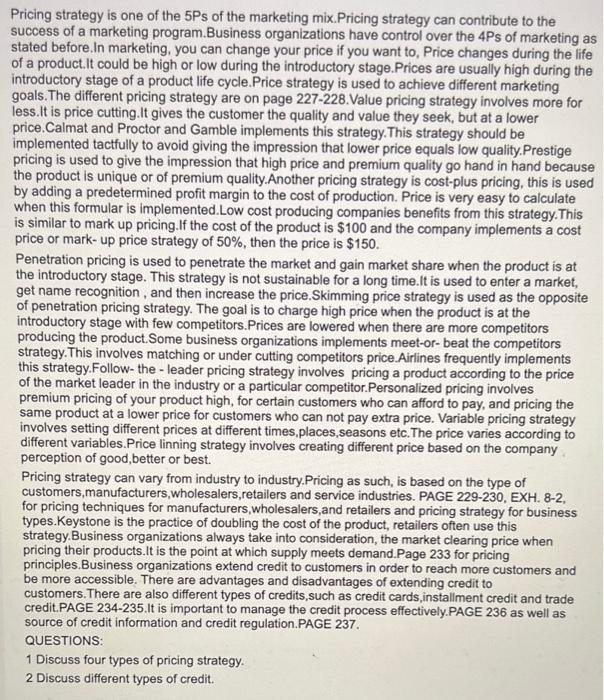Pricing strategy is one of the 5Ps of the marketing mix.Pricing strategy can contribute to the success of a marketing program. Business organizations have control over the 4Ps of marketing as stated before.In marketing, you can change your price if you want to, Price changes during the life of a product. It could be high or low during the introductory stage.Prices are usually high during the introductory stage of a product life cycle.Price strategy is used to achieve different marketing goals. The different pricing strategy are on page 227-228.Value pricing strategy involves more for less.It is price cutting. It gives the customer the quality and value they seek, but at a lower price.Calmat and Proctor and Gamble implements this strategy. This strategy should be implemented tactfully to avoid giving the impression that lower price equals low quality. Prestige pricing is used to give the impression that high price and premium quality go hand in hand because the product is unique or of premium quality.Another pricing strategy is cost-plus pricing, this is used by adding a predetermined profit margin to the cost of production. Price is very easy to calculate when this formular is implemented.Low cost producing companies benefits from this strategy. This is similar to mark up pricing. If the cost of the product is $100 and the company implements a cost price or mark- up price strategy of 50%, then the price is $150. Penetration pricing is used to penetrate the market and gain market share when the product is at the introductory stage. This strategy is not sustainable for a long time.It is used to enter a market, get name recognition, and then increase the price.Skimming price strategy is used as the opposite of penetration pricing strategy. The goal is to charge high price when the product is at the introductory stage with few competitors.Prices are lowered when there are more competitors producing the product.Some business organizations implements meet-or- beat the competitors strategy. This involves matching or under cutting competitors price.Airlines frequently implements this strategy. Follow- the - leader pricing strategy involves pricing a product according to the price of the market leader in the industry or a particular competitor.Personalized pricing involves premium pricing of your product high, for certain customers who can afford to pay, and pricing the same product at a lower price for customers who can not pay extra price. Variable pricing strategy involves setting different prices at different times, places, seasons etc. The price varies according to different variables.Price linning strategy involves creating different price based on the company perception of good, better or best. Pricing strategy can vary from industry to industry.Pricing as such, is based on the type of customers, manufacturers, wholesalers, retailers and service industries. PAGE 229-230, EXH. 8-2, for pricing techniques for manufacturers, wholesalers, and retailers and pricing strategy for business types.Keystone is the practice of doubling the cost of the product, retailers often use this strategy. Business organizations always take into consideration, the market clearing price when pricing their products. It is the point at which supply meets demand.Page 233 for pricing principles.Business organizations extend credit to customers in order to reach more customers and be more accessible. There are advantages and disadvantages of extending credit to customers. There are also different types of credits,such as credit cards, installment credit and trade credit.PAGE 234-235.It is important to manage the credit process effectively.PAGE 236 as well as source of credit information and credit regulation.PAGE 237. QUESTIONS: 1 Discuss four types of pricing strategy. 2 Discuss different types of credit







